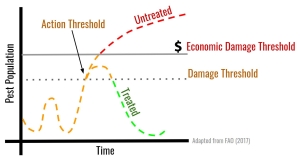Doutorando: Jhonatan Paulo Barro. Data: 22/10/2019, às 16:00 horas no Anfiteatro do ESB. Orientador: Prof. Emerson M. Del Ponte
The concept and use of thresholds in pest management was proposed during the 1950s by entomologists who were concerned with the indiscriminate and unjustified use of chemicals. The concept was transferred to plant pathology and used as an aid for decision-making in disease control with fungicides. Whenever a threshold (a quantifiable unit) is reached, an action is required, and this is called action threshold. Threshold values are defined as a direct measure of disease intensity or pathogen population size or indirectly using models/rules that take environmental variables as predictors of disease risk. After development, threshold-based decisions are evaluated in replicated experiments and compared with one or more standard management practices with regards to efficiency and profitability. Thresholds are most suited to situations in which disease control can be optimal, yet profitable, with less input (e.g. fungicide sprays), which leds to both direct and indirect benefits such as minimize fungicide resistance issues. Additionally, phytosanitary thresholds can help to limit the movement of pathogen inoculum through seed or by eradicating infected plants. Although appealing, the broader adoption of threshold is limited and influenced by aspects related to both research and extension. For instance, disease measurements or predictions may suffer from uncertainty or constant need of evaluation in the face of changes in management practices, environment, and pathogen population. There may be costs for implementing such systems, which should be taken into account. Finally, lack of understanding or resistance to change, due to the uncertainty in the threshold estimates, by growers slow down adoption rate. This is especially true if there is risk of financial loss from not spraying preventatively, which can be perceived at different levels by growers. In this seminar, threshold definition and applications will be presented as well some perspectives to overcome the challenges and improve the use of this tool in disease management.

